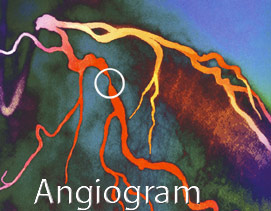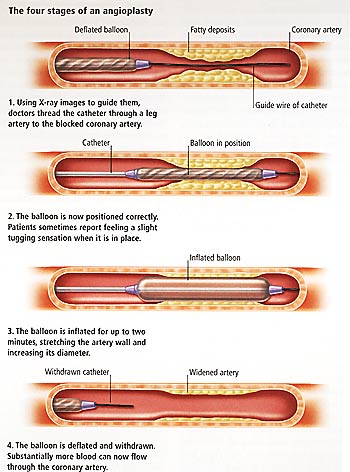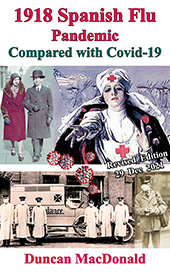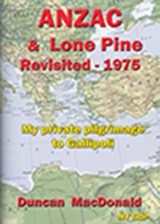Duncan MacDonald
Jakarta 10 April 2008
What a Heart Attack Feels Like It is important you are aware of the warning signs of a heart attack. Unlike in the movies, where a person having a heart attack gropes his chest and falls to the floor, (and in the movies, unlike reality, it's always a man) the symptoms of a heart attack are often more subtle. They differ between men and women and from person to person 
Men generally will report;
◊ Pain or discomfort in the chest that radiates to the shoulder or arms, to the upper back near the shoulder blades, or to the neck or jaw.
◊ Uncomfortable pressure, tightness, fullness, or an ache at the centre of the chest
◊ Shortness of breath, sweating, nausea or dizziness
Women on the other hand usually report;
◊ Pain in both arms or shoulders
◊ Chest cramping or dull pain between the breasts
◊ Shortness of breath
◊ Feeling of indigestion
◊ Lower abdominal pain
◊ Severe fatigue (usually not caused by heart attack) [ 1 ]
What to do if you are having a heart attack If you, or someone near you, is having a heart attack follow these three simple steps;
1. Call 118 for an ambulance in Indonesia or the Emergency Number on your Health Insurance Card. You may be reluctant to call for help, especially if you are not sure your discomfort is caused by a heart attack or indigestion, but doing so will get you better – and safer - treatment. Emergency medical personnel can restart your heart if it stops beating. They can give you oxygen to help you breathe and aspirin and other treatment to prevent further blood clots.
Another good reason for emergency transport is quicker treatment once you get to hospital. Heart attack victims who arrive by ambulance receive appropriate treatment sooner than those who arrive by car.
If you have someone drive you to a hospital, tell the person in emergency desk in no uncertain terms "I think I am having a heart attack" Don't just sit in the waiting room.
Do not, under any circumstances, drive yourself to hospital.
2. Chew a regular strength aspirin. If you cannot chew an aspirin, mash it up in a glass of water and drink it down. Do not take the aspirin whole – it can take too long for the body to break it down and absorb. Aspirin "poisons" platelets so they do not form clots well
3. Call a friend or family member if you are alone, and tell them what's going on.
Act in time The average person waits 2 hours or more after the onset of heart attack symptoms, to call for help. One in four people wait more than five hours. It's not ignorance – it takes the average doctor who is having a heart attack, two hours as well.
Approx 920,000 people suffered heart attacks in 2007 in USA. 450,000 died. Of those who died, about half died within an hour of onset of the symptoms and before they reached a hospital. [ 2 ]
275,000 people suffered heart attack in the UK in 2007. 120,000 died. Medical care is improving – it took 2 years to receive heart surgery under NHS in 1996. That time was reduced to 3 months in 2005. [ 3 ]
Proceedures to open blocked arteries The two main procedures to restore blood flow to the arteries are angioplasty – performed by cardiologists and coronary artery bypass graft surgery, performed by heart surgeons.
Angiogram is a contrast x-ray used to detect abnormalities, such as narrowing in the coronary arteries. Dye is injected into the blood vessels to make them clearly visible on an X-ray.
Before Angioplasty or Surgery – If your doctor has recommended angioplasty or cardiac surgery, seek out a cardiologist or heart surgeon where the procedure is frequently performed. Research has shown that outcomes are best when performed by specialists with the most experience [ 5 ]
Angioplasty aims to relieve angina by widening the affected arteries. It is a less invasive alternative to open heart surgery. A tiny balloon is inflated to open up the coronary artery that has become clogged with fatty deposits. The patient is usually awake throughout the procedure. A catheter (hollow tube) carrying a balloon, is inserted into a blood vessel in the groin and guided, with the help of x-rays, through the arteries to the blockage. The balloon is inflated several times to widen the artery. There is a relatively small risk of myocardial infarction (death of part of the middle layer of the heart wall), or a split in the artery, which will necessitates bypass grafting. In many cases, a titanium mesh cylinder, called a stent, is placed in the artery to keep it open and reduce the risk of narrowing again.
the coronary artery that has become clogged with fatty deposits. The patient is usually awake throughout the procedure. A catheter (hollow tube) carrying a balloon, is inserted into a blood vessel in the groin and guided, with the help of x-rays, through the arteries to the blockage. The balloon is inflated several times to widen the artery. There is a relatively small risk of myocardial infarction (death of part of the middle layer of the heart wall), or a split in the artery, which will necessitates bypass grafting. In many cases, a titanium mesh cylinder, called a stent, is placed in the artery to keep it open and reduce the risk of narrowing again.
Open heart surgery or Coronary Bypass A blood vessel is taken from the leg or chest and used to bypass the narrowest part of the artery. This graft, which may last 8 – 10 years, may be offered if symptoms are still present despite drug therapy, and angioplasty is not appropriate.
Conclusion: Your Editor/Webmaster needed angioplasty on three blocked arteries in June 2007. After investigating facilities in Singapore and Australia and advice from Dr Richard Tomlins of the Australian Embassy in Jakarta, I decided to have the procedure done in Indonesia by an Indonesian Interventional Cardiologist & Internist, who had practiced for 12 years in Melbourne, Australia: Dr Dasaad Mulijono, MBBS (Hons), FIHA, FIMSANZ, FRACGP, FRACP, PhD Interventional Cardiologist & Internist (Australia)
Dr Dasaard has performed over 8,000 angiograms and over 1,200 angioplasty operations [as at June 2007]. My procedure was carried out in Jakarta. The operation took 50 minutes. I was discharged from hospital within 2 days and was playing tennis 5 days later. Dr Dasaard is Director of Cardiac Center, at RS Bethsaida, Jakarta.
Unfortunately it hasn't improved my tennis skills.
 Coronary Heart Disease
Coronary Heart Disease

Men generally will report;
◊ Pain or discomfort in the chest that radiates to the shoulder or arms, to the upper back near the shoulder blades, or to the neck or jaw.
◊ Uncomfortable pressure, tightness, fullness, or an ache at the centre of the chest
◊ Shortness of breath, sweating, nausea or dizziness
Women on the other hand usually report;
◊ Pain in both arms or shoulders
◊ Chest cramping or dull pain between the breasts
◊ Shortness of breath
◊ Feeling of indigestion
◊ Lower abdominal pain
◊ Severe fatigue (usually not caused by heart attack) [ 1 ]
What to do if you are having a heart attack If you, or someone near you, is having a heart attack follow these three simple steps;
1. Call 118 for an ambulance in Indonesia or the Emergency Number on your Health Insurance Card. You may be reluctant to call for help, especially if you are not sure your discomfort is caused by a heart attack or indigestion, but doing so will get you better – and safer - treatment. Emergency medical personnel can restart your heart if it stops beating. They can give you oxygen to help you breathe and aspirin and other treatment to prevent further blood clots.
Another good reason for emergency transport is quicker treatment once you get to hospital. Heart attack victims who arrive by ambulance receive appropriate treatment sooner than those who arrive by car.
If you have someone drive you to a hospital, tell the person in emergency desk in no uncertain terms "I think I am having a heart attack" Don't just sit in the waiting room.
Do not, under any circumstances, drive yourself to hospital.
2. Chew a regular strength aspirin. If you cannot chew an aspirin, mash it up in a glass of water and drink it down. Do not take the aspirin whole – it can take too long for the body to break it down and absorb. Aspirin "poisons" platelets so they do not form clots well
3. Call a friend or family member if you are alone, and tell them what's going on.
Act in time The average person waits 2 hours or more after the onset of heart attack symptoms, to call for help. One in four people wait more than five hours. It's not ignorance – it takes the average doctor who is having a heart attack, two hours as well.
Approx 920,000 people suffered heart attacks in 2007 in USA. 450,000 died. Of those who died, about half died within an hour of onset of the symptoms and before they reached a hospital. [ 2 ]
275,000 people suffered heart attack in the UK in 2007. 120,000 died. Medical care is improving – it took 2 years to receive heart surgery under NHS in 1996. That time was reduced to 3 months in 2005. [ 3 ]
Please be aware - you can receive excellent heart surgery in Jakarta within 24 hours [ 4 ]
provided you have appropriate medical insurance or substantial cash - See Dr Dasaad below |

Angiogram is a contrast x-ray used to detect abnormalities, such as narrowing in the coronary arteries. Dye is injected into the blood vessels to make them clearly visible on an X-ray.
Before Angioplasty or Surgery – If your doctor has recommended angioplasty or cardiac surgery, seek out a cardiologist or heart surgeon where the procedure is frequently performed. Research has shown that outcomes are best when performed by specialists with the most experience [ 5 ]
Angioplasty aims to relieve angina by widening the affected arteries. It is a less invasive alternative to open heart surgery. A tiny balloon is inflated to open up
 the coronary artery that has become clogged with fatty deposits. The patient is usually awake throughout the procedure. A catheter (hollow tube) carrying a balloon, is inserted into a blood vessel in the groin and guided, with the help of x-rays, through the arteries to the blockage. The balloon is inflated several times to widen the artery. There is a relatively small risk of myocardial infarction (death of part of the middle layer of the heart wall), or a split in the artery, which will necessitates bypass grafting. In many cases, a titanium mesh cylinder, called a stent, is placed in the artery to keep it open and reduce the risk of narrowing again.
the coronary artery that has become clogged with fatty deposits. The patient is usually awake throughout the procedure. A catheter (hollow tube) carrying a balloon, is inserted into a blood vessel in the groin and guided, with the help of x-rays, through the arteries to the blockage. The balloon is inflated several times to widen the artery. There is a relatively small risk of myocardial infarction (death of part of the middle layer of the heart wall), or a split in the artery, which will necessitates bypass grafting. In many cases, a titanium mesh cylinder, called a stent, is placed in the artery to keep it open and reduce the risk of narrowing again.Open heart surgery or Coronary Bypass A blood vessel is taken from the leg or chest and used to bypass the narrowest part of the artery. This graft, which may last 8 – 10 years, may be offered if symptoms are still present despite drug therapy, and angioplasty is not appropriate.
Conclusion: Your Editor/Webmaster needed angioplasty on three blocked arteries in June 2007. After investigating facilities in Singapore and Australia and advice from Dr Richard Tomlins of the Australian Embassy in Jakarta, I decided to have the procedure done in Indonesia by an Indonesian Interventional Cardiologist & Internist, who had practiced for 12 years in Melbourne, Australia: Dr Dasaad Mulijono, MBBS (Hons), FIHA, FIMSANZ, FRACGP, FRACP, PhD Interventional Cardiologist & Internist (Australia)
Dr Dasaard has performed over 8,000 angiograms and over 1,200 angioplasty operations [as at June 2007]. My procedure was carried out in Jakarta. The operation took 50 minutes. I was discharged from hospital within 2 days and was playing tennis 5 days later. Dr Dasaard is Director of Cardiac Center, at RS Bethsaida, Jakarta.
Unfortunately it hasn't improved my tennis skills.





